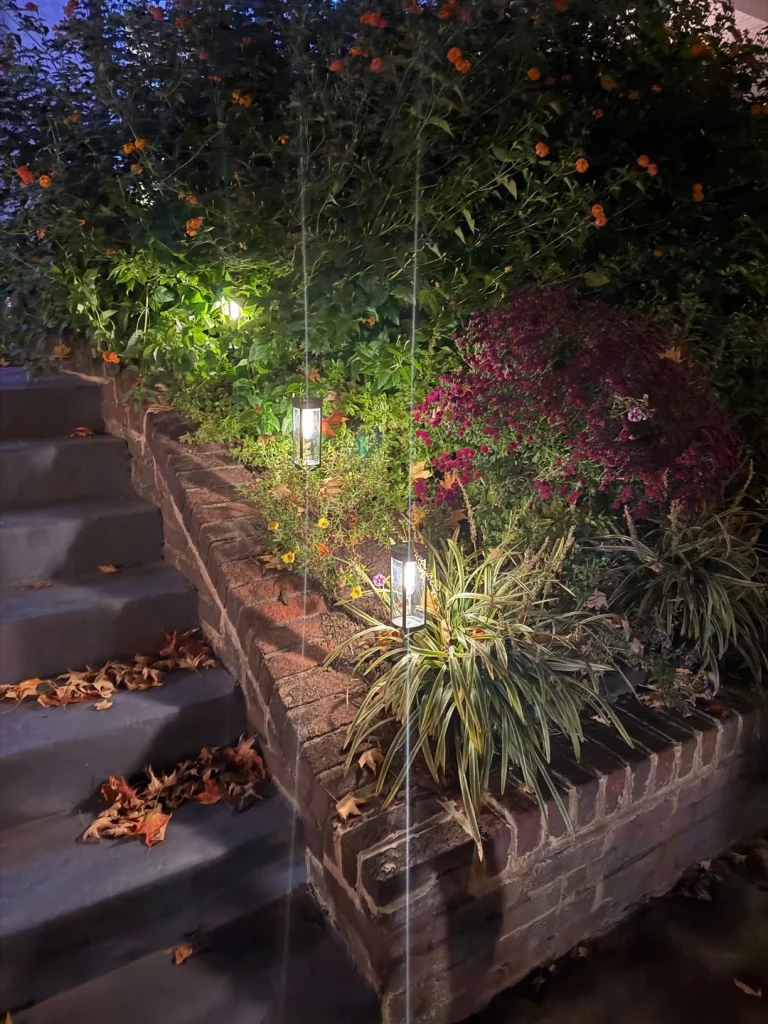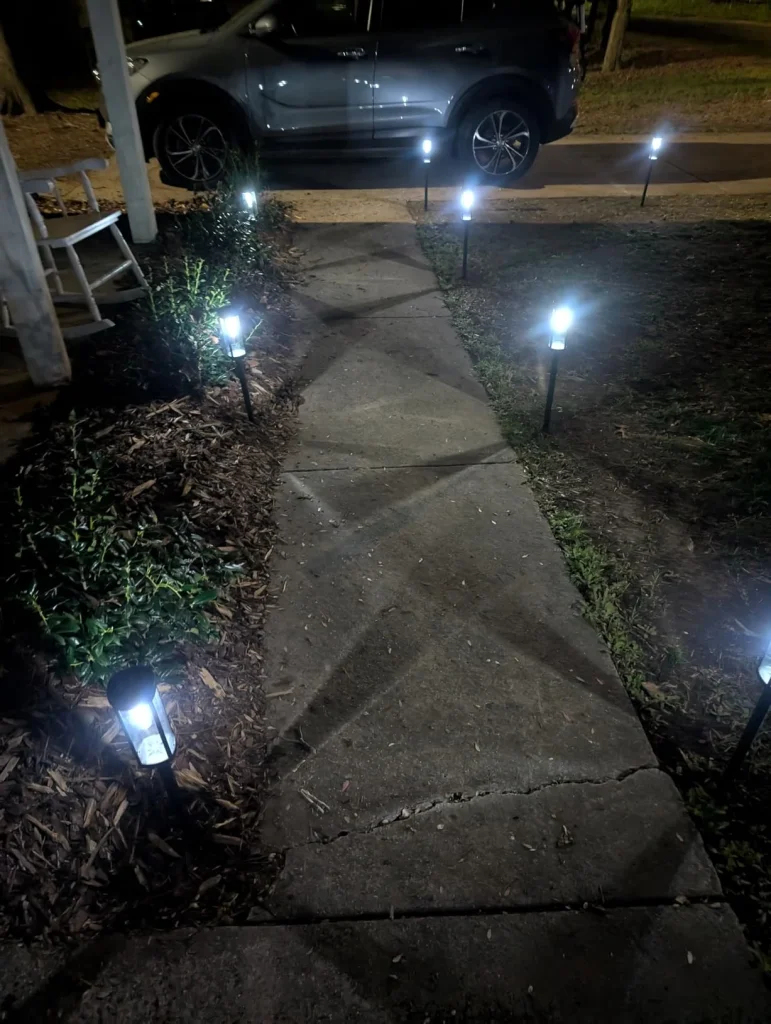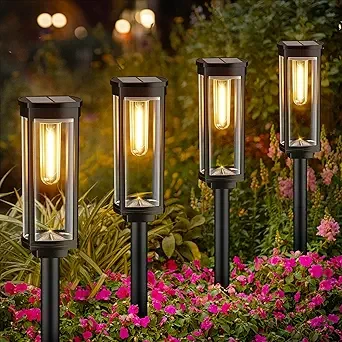Introduction: The Basics of Solar Lights for Outside Stairs
Outdoor staircases, whether leading to a porch, deck, or garden, often pose safety risks in low-light conditions. Solar lights for outside stairs provide an eco-friendly, cost-effective solution to illuminate these areas, enhancing safety and aesthetics. Powered by renewable solar energy, these lights harness sunlight during the day to provide reliable nighttime illumination. Unlike traditional wired lighting, solar stair lights require no complex electrical setups, making them an ideal choice for homeowners seeking sustainable and low-maintenance outdoor lighting solutions.

The appeal of solar lights for outside stairs lies in their versatility and ease of use. Available in various designs—such as step-mounted, wall-mounted, or recessed options—they cater to different architectural styles and personal preferences. These lights not only improve visibility but also add a touch of elegance to outdoor spaces. This article explores the core features, installation tips, maintenance practices, and key considerations for choosing the best solar lights for outside stairs to ensure safety and durability.
Core Functional Features
Safety Illumination and Brightness Adaptation
The primary function of solar lights for outside stairs is to enhance safety by illuminating steps to prevent trips and falls. These lights are designed to provide adequate brightness without overwhelming the senses. Most models feature LED bulbs, which offer bright, energy-efficient illumination. The brightness level, typically measured in lumens, ranges from 10 to 100 lumens per light, sufficient to light up individual steps while maintaining a soft, inviting glow.
Advanced solar lights for outside stairs often include adaptive brightness features, such as motion sensors or dusk-to-dawn functionality. Motion-activated lights turn on only when someone approaches, conserving energy and extending battery life. Dusk-to-dawn models automatically activate at nightfall, ensuring consistent illumination throughout the evening. These features make solar stair lights both practical and energy-efficient, catering to the needs of busy homeowners.
Anti-Glare and Environmentally Integrated Design
A well-designed solar light for outside stairs balances functionality with aesthetics. Anti-glare technology is a critical feature, preventing harsh light from causing discomfort or disorientation. Many solar stair lights use frosted lenses or angled designs to diffuse light evenly, creating a soft glow that illuminates steps without blinding users.
Additionally, these lights are crafted to blend seamlessly with outdoor environments. Available in materials like stainless steel, durable plastic, or weather-resistant aluminum, solar lights for outside stairs come in finishes that complement natural stone, wood, or modern concrete staircases. Compact designs ensure they don’t obstruct pathways, while sleek, minimalist styles enhance the visual appeal of outdoor spaces. Some models even offer customizable color temperatures, allowing users to choose between warm or cool lighting to match their home’s ambiance.
Installation Adaptation Points
Stair Structure Compatibility
Installing solar lights for outside stairs requires careful consideration of the staircase’s structure and material. Whether your stairs are made of wood, concrete, brick, or metal, there’s a solar light design to suit your needs. Common installation types include:
- Surface-Mounted Lights: These are affixed directly onto the step’s surface or riser using screws or adhesive. They’re ideal for concrete or stone stairs, where drilling is feasible.
- Recessed Lights: Embedded into the stair riser or tread, recessed lights offer a sleek, unobtrusive look, perfect for modern or minimalist designs.
- Wall-Mounted Lights: Mounted on adjacent walls or railings, these are suitable for stairs with nearby vertical surfaces, providing overhead or side illumination.
Before installation, measure the dimensions of your stairs to ensure proper spacing and alignment. Most solar lights for outside stairs are designed for easy DIY installation, with included mounting hardware and instructions. However, for complex setups or recessed designs, consulting a professional may ensure optimal placement and stability.
Choosing the Optimal Light-Receiving Position
The efficiency of solar lights for outside stairs depends heavily on their exposure to sunlight. Solar panels, often integrated into the light fixture or connected via a small cable, must be positioned to receive maximum daylight. Key considerations include:
- Sunlight Exposure: Place solar panels in areas with direct sunlight for at least 6–8 hours daily. Avoid shaded spots under trees, overhangs, or awnings.
- Orientation: In the Northern Hemisphere, south-facing panels capture the most sunlight. Adjust the angle of adjustable panels to optimize solar absorption.
- Weather Considerations: Ensure the solar panel’s location is free from debris, such as leaves or snow, which can block sunlight and reduce charging efficiency.
Some advanced models feature detachable solar panels, allowing you to place the panel in a sunny location while mounting the light itself in a shaded stairwell. Testing the light’s performance over a few days can help confirm whether the chosen position provides adequate charging.

Usage and Maintenance Tips
Daily Cleaning and Troubleshooting
To ensure the longevity and performance of solar lights for outside stairs, regular maintenance is essential. Dust, dirt, and debris can accumulate on solar panels, reducing their ability to charge effectively. Clean the panels every few months using a soft cloth and mild soapy water, avoiding abrasive materials that could scratch the surface.
If a light fails to illuminate, follow these troubleshooting steps:
- Check Sunlight Exposure: Ensure the solar panel isn’t obstructed by new foliage or structures.
- Inspect the Battery: Most solar lights for outside stairs use rechargeable NiMH or lithium-ion batteries. If the light dims or fails after a few years, the battery may need replacement. Refer to the manufacturer’s guidelines for compatible battery types.
- Examine Connections: Loose wiring or corrosion in detachable panel systems can disrupt performance. Check connections and clean any corrosion with a dry cloth.
- Test the Sensor: For motion-activated lights, ensure the sensor isn’t blocked or misaligned. Adjust its sensitivity if the light triggers too frequently or not at all.
Regular checks, especially after severe weather, can prevent minor issues from escalating. Most solar lights for outside stairs are built to withstand rain, snow, and extreme temperatures, but proactive care ensures consistent performance.
Battery Life Optimization Tips
Maximizing the runtime of solar lights for outside stairs involves strategic usage and care. Here are some practical tips:
- Seasonal Adjustments: In winter, when daylight hours are shorter, tilt solar panels to capture more sunlight or relocate detachable panels to sunnier spots.
- Energy-Saving Modes: Use lights with adjustable brightness or motion sensors to conserve battery life. For example, setting lights to low brightness during off-peak hours extends runtime.
- Battery Maintenance: If the light allows battery access, remove and store batteries in a cool, dry place during extended periods of non-use, such as during a vacation.
- Upgrade to High-Capacity Batteries: Some models support upgraded batteries with higher mAh ratings, providing longer illumination times.
By implementing these strategies, users can enjoy reliable illumination from their solar lights for outside stairs even during cloudy days or high-traffic evenings.
Choosing and Using Solar Lights: A Summary
Selecting the right solar lights for outside stairs involves balancing functionality, aesthetics, and durability. Key factors to consider include:
- Brightness and Coverage: Choose lights with appropriate lumen output for your staircase size. A single light per step is typically sufficient, but wider stairs may require multiple fixtures.
- Durability: Opt for lights with an IP65 or higher waterproof rating to withstand outdoor conditions. Stainless steel or UV-resistant plastic models offer excellent longevity.
- Design: Select a style that complements your home’s exterior, whether modern, rustic, or traditional. Anti-glare and customizable lighting options enhance both safety and ambiance.
- Ease of Installation: Prioritize models with clear instructions and included hardware for hassle-free setup. If you’re not comfortable with DIY installation, consider professional assistance.
When using solar lights for outside stairs, prioritize proper placement and regular maintenance to maximize performance. Test the lights after installation to ensure even illumination across all steps, and periodically check for obstructions or wear. By choosing high-quality solar lights and following best practices for installation and care, you can create a safer, more inviting outdoor space.
In conclusion, solar lights for outside stairs offer an eco-friendly, low-maintenance solution for enhancing outdoor safety and aesthetics. Their energy-efficient design, combined with versatile installation options and durable construction, makes them a smart investment for any homeowner. Whether you’re illuminating a garden path, a deck staircase, or a front porch, these lights provide reliable performance while reducing your environmental footprint. By understanding their features, installation requirements, and maintenance needs, you can enjoy well-lit stairs that enhance both safety and style for years to come.


Leave a Reply